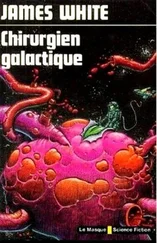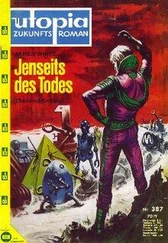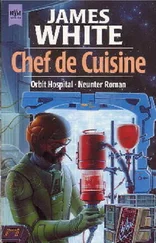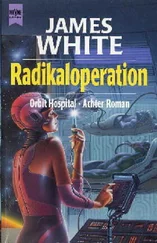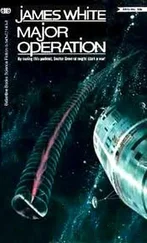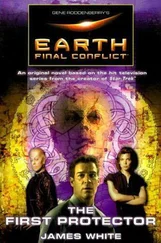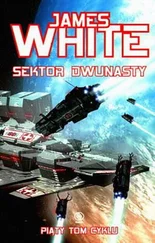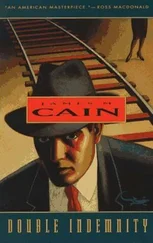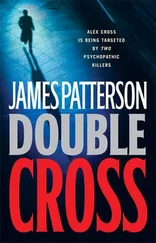When he was deep inside the control section he drifted as close as possible to the inner door that would give access to the least injured of the ship’s two organic survivors, a position where he could monitor the other’s emotional responses with optimum accuracy. The robot drifted passively less than a meter away. He knew that the tiny metal digits encircling its body were capable of ripping open his spacesuit in a matter of seconds, but he also knew or rather he felt fairly sure — that it would remain passive unless he tried to open the inner door. “Ready when you are, friend Fletcher,” he said.
A few seconds later an immediate change in the alien’s emotional radiation as well as the image on his helmet screen told him that, in the space between Rhabwar and the distressed alien ship, the show had begun.
“It sees the external image,” Prilicla reported excitedly “There are feelings of awareness, curiosity, and puzzlement.”
The captain didn’t reply but one of the other officers laughed softly and saidin a voice not meant to be overheard, “I would feel puzzled, too, if somebody projected the image of a star field onto another star field.”
The projected star field remained unaltered for a few seconds, then slowly it began to shrink and condense so that more and more stars moved in from the edges of the three-dimensional projection until it took on the glittering, unmistakable, spiral shape of the Galaxy itself.
The survivor’s concentration was now total.
Gradually the fine detail of the image coarsened, the wisps and streamers of interstellar gas were erased, and the number of stars was reduced to a few hundred which became large enough to have been counted individually. One of them was highlighted inside a circle of bright green and the circle increased rapidly in size until a stylized representation of the star and its system of planets filled the projection volume for a few seconds before the image changed again.
The viewpoint zoomed in on that solar system’s inhabited planet, showing the swirling, tattered cloud formations that could not quite hide the continental outlines. As it swooped closer and lower it slowed until the viewpoint was giving panoramic views of the planetary surface, seascapes, ice fields, mountains, tropical greenery, and great, sprawling cities with their interconnecting road systems. Then the image was reduced suddenly in size and moved to one side so that it filled only half of the projection.
The other half displayed an equally detailed representation of the world’s dominant intelligent life-form.
It was the picture of an enormous, incredibly fragile flying insect with a tubular, exoskeletal body that supported six sucker tipped pencil-thin legs, four even more delicately fashioned and precise manipulators, and two sets of wide, iridescent, and almost transparent wings. The head was a convoluted eggshell so finely structured that the sensory organs, particularly the two large, lowing eyes projecting from it, seemed ready to fall off at the first sudden movement. The head, manipulators — some of them holding tools — and legs were bent or rotated to demonstrate their limits of movement while the wings wafted slowly up and down as they broke up and reflected iridescent highlights like mobile rainbows. It was the picture of a Cinrusskin, one of the race generally held to be the most beautiful and delicate life-forms known to the explored reaches of the galaxy.
Then the limb motions ceased, the wings folded away, and the body was suddenly encased in a spacesuit identical to the one Prilicla wore.
“As well as the background discomfort, I detect feelings of surprise and growing curiosity,” Prilicla reported. “Go to the next stage.”
They had shown a picture of Prilicla’s race first because he had already been seen by the alien casualty and seemed to be trusted by it. But now its education and, hopefully, its ability to trust had to be widened.
Next was shown the solar system, planet, meteorology, rural and city environments of Kelgia, accompanied by a picture of a single member of its dominant species. The undulating, multi-Pedal, caterpillar-like body with its silver, continually mobile fur, the narrow cone of a head, and the tiny forward manipulators, aroused no feelings of antipathy in the casualty, nor did the similar Material on the crablike Melfan or the six-legged, elephantine Tralthan life-forms that followed it. But when the Hudlar planet species were shown, there was a subtle change. Hudla was a heavy-gravity world pulling four Earth Gs whose nearly opaque atmosphere resembled a thick, dense soup, it was rich in the suspended animal and vegetable nutrients on which the Hudlars lived. It was a world of constant storms that had forced its natives to build underground. Only a Hudlar could love it, Prilicla thought, and then, not very much.
He said, “Now there are feelings suggestive of fear and familiarity. It is as if the casualty is recognizing a habitual enemy To most people, Melfans and Tralthans are visually more horrendous than the smooth-bodied Hudlars, so it may well be that it is the planet Hudla itself rather that its native life-forms that is causing this reaction.”
“Is this a guess, Doctor,” said the captain, “or one of your feelings?”
“A strong feeling,” he replied.
“I see,” said the other. It cleared its throat and added, “If your casualty considers Hudla as something like home, I can feel a certain sympathy for it in spite of what it did to Terragar. Shall I proceed?”
“Please,” said Prilicla, and the lesson continued.
Showing the planets and living environments of the sixty-seven intelligent species that comprised the Galactic Federation had never been their intention because the process would have been unnecessarily long and this was, after all, a primary lesson. The widely different types like the storklike, tripedal Nallajims, the multicolored, animated Gogleskan haystacks, the slimy, chlorine-breathing Illensans, and the radiation-eating Telfi, among others, were included, but so also were the DBDG classifications from Earth, Nidia, and Orligia. Those three were there deliberately because the prime purpose of the lesson was to instill in the alien casualties a feeling of trust for their Earth-human rescuers.
“It isn’t working,” said Prilicla, disappointed. “Every time you showed a DBDG, regardless of its size or whether it was a large, hairy Orligian, an Earth-human, or a half-sized, red-furred Nidian, the reaction was the same — one of intense fear and hatred. It will be extremely difficult to make these people trust you.
“What on Earth,” said the captain, “could we ever have done to make them feel that way?”
“It was not done on Earth, friend Fletcher,” said Prilicla. “Rut the show isn’t over yet. Please continue.”
The format changed again. Instead of showing individual planets and subjects, two- and three-member groups comprising different species were shown meeting and talking, sometimes with their children present, or working together on various technical projects. In some of them they were encased in spacesuits while they rescued other-species casualties from damaged ships. The pictures’ application to the present situation, he hoped, was plain. Then the scene changed again to show all of the subjects, forming the rim of wheel and shown in scale, from the diminutive Nallajims and Cinrusskins, up to the massive Tralthans and Hudlars of more than ten times that body-weight. At the hub of the circle was shown a tiny, glittering representation of the galaxy, from which radiated misty spokes joining it to the individual species on the rim. Then the individual species were pictured again, this time with all of them displayed as being the same size, in order, it was again hoped, to illustrate equality of importance. Several seconds passed. At this extreme range Prilicla could not feel, but he could imagine the captain’s anxiety as it spoke. “Well, Doctor,” it said urgently, “was there a response?” “There was, friend Fletcher,” he replied, “but I’m still trying for an exact analysis of the emotional radiation. In conjunction with the background feelings of anxiety, which may be caused by worry over its companion who it can no longer contact, there are strong feelings of excitement, wonder, and, I feel sure, comprehension. I’d say that it understood our lesson.”
Читать дальше

